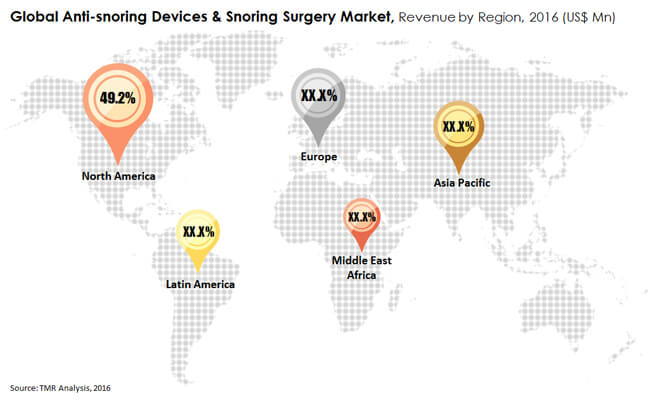Anti-Snoring Devices Market is Expected to Grow Exponentially
A very interesting study was just released from MedGadget.
Snoring is the result of vibration of respiratory structures which leads to production of sound. The sound produced is the result of obstructed air movement during breathing while sleeping. Anti-snoring devices help in the reduction.
Technological advancements in anti-snoring devices, growth in cigarette and alcohol consumption, rise in geriatric and obese population, and increase in awareness in developed countries about the ill effects of snoring and benefits of associated treatments drive the anti-snoring devices market.
However, high cost of custom-made oral devices, and poor efficacy and lack of scientific validation of the anti-snoring devices currently available in the market restrain this growth. The growth opportunities in emerging economies of Asia-Pacific and LAMEA, and presence of a large untreated population base are expected to provide numerous opportunities for market growth during the forecast period.
The report segments the market based on product and geography. Based on product, the market is divided into oral appliances, nasal devices, position control devices, chin straps, tongue-stabilizing devices, and expiratory positive airway pressure (EPAP) therapy devices.
Geographically, the market is analyzed across North America (U.S., Canada, and Mexico), Europe (Germany, France, Italy, UK, Spain, and rest of Europe), Asia-Pacific (China, Japan, Australia, India, South Korea, and rest of Asia-Pacific), and LAMEA (Brazil, South Africa, Saudi Arabia, and rest of LAMEA).
The major companies profiled in the report include Sleeping Well, LLC, Apnea Sciences Corporation, Somnomed Ltd., Airway Management Inc., Theravent, Inc., Tomed Dr. Toussaint Gmbh, GlaxoSmithKline plc, and others.
The most notable aspect of this research study is the number of EPAP devices included. In other words, check out that HUGE column of EPAP devices!
Not to mention, most nasal devices are considered EPAP as well.
Now seems to be the perfect time to enter into the market with a cutting edge innovation.
Snoring is the result of vibration of respiratory structures which leads to production of sound. The sound produced is the result of obstructed air movement during breathing while sleeping. Anti-snoring devices help in the reduction.
Technological advancements in anti-snoring devices, growth in cigarette and alcohol consumption, rise in geriatric and obese population, and increase in awareness in developed countries about the ill effects of snoring and benefits of associated treatments drive the anti-snoring devices market.
However, high cost of custom-made oral devices, and poor efficacy and lack of scientific validation of the anti-snoring devices currently available in the market restrain this growth. The growth opportunities in emerging economies of Asia-Pacific and LAMEA, and presence of a large untreated population base are expected to provide numerous opportunities for market growth during the forecast period.
The report segments the market based on product and geography. Based on product, the market is divided into oral appliances, nasal devices, position control devices, chin straps, tongue-stabilizing devices, and expiratory positive airway pressure (EPAP) therapy devices.
Geographically, the market is analyzed across North America (U.S., Canada, and Mexico), Europe (Germany, France, Italy, UK, Spain, and rest of Europe), Asia-Pacific (China, Japan, Australia, India, South Korea, and rest of Asia-Pacific), and LAMEA (Brazil, South Africa, Saudi Arabia, and rest of LAMEA).
The major companies profiled in the report include Sleeping Well, LLC, Apnea Sciences Corporation, Somnomed Ltd., Airway Management Inc., Theravent, Inc., Tomed Dr. Toussaint Gmbh, GlaxoSmithKline plc, and others.
Anti-Snoring Devices Market Key Segments
By Product- Oral Appliances
- Mandibular Advancement Devices (MADs)
- Non-Custom MADs
- Custom-Made MADs
- Tongue-retaining Devices
- Nasal Devices
- External Nasal Dilators
- Other Nasal Devices
- Position Control Devices
- Chin Straps
- Tongue-stabilizing Devices
- Expiratory Positive Airway Pressure (EPAP) Therapy Devices
- 3-unit Bridges
- 4-unit Bridges
- Maryland Bridges
- Cantilever Bridges
- Dentures
- Complete Dentures
- Partial Dentures
- Abutments
- Temporary Abutments
- Definitive Abutments
- Veneers Inlays & Onlays
This study was first published on MedGadget here. You can read the full research (not free) here.
Not to mention, most nasal devices are considered EPAP as well.
Now seems to be the perfect time to enter into the market with a cutting edge innovation.

Comments
Post a Comment